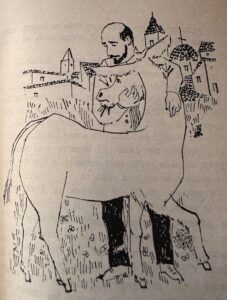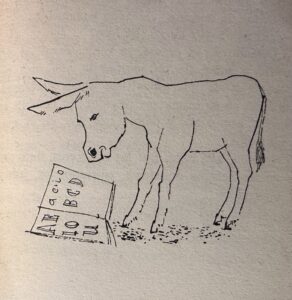By now, we all know that in several recent films donkeys have been making appearances on the screen. In the case of EO, the nominee from Poland for Best Foreign Film, it was actually six donkeys sharing the protagonist’s role: Tako, Hola, Ettore, Roco, Marielle –who loved croissants instead of carrots–, and Mela. Jenny was the faithful companion of Pádriaic’s (Collin Farrell) in The Banshees of Inisherin; supposedly she was also the donkey who made an entrance during the Oscars’ ceremony in another nominated film. A nameless wild donkey made a sad appearance in Triangle of Sadness tragic conclusion. Even in Navalny, the winning documentary about Alexei Navalny’s poisoning and eventual imprisonment, a donkey is present in a sweet family sequence when Alexei is recuperating in Germany’s Black Forest. I hope it isn’t a spoilers’ alert if I tell you that, except for this last one, with her striking orange ears and mane, all the others donkeys come to a heartbreaking end –at least fictionally.
For the Spaniard in me it is impossible to see all these films without thinking about our most illustrious donkey, Platero, which means made from silver from the Spanish “plata.”  According to Juan Ramón Jiménez, the author of Platero y yo (Platero and I), his friend is: “a small donkey, a soft, hairy donkey: so soft to the touch that he might be said to be made of cotton, with no bones. Only the jet mirrors of his eyes are hard like two black crystal scarabs.” When Platero y yo was published in 1914, it was considered a children’s book due to its innocent appearance (sort of like EO and its PG 13 rating). And, although there are many children versions of Platero, the 138 chapters, written as prose-poems, are nothing but.
According to Juan Ramón Jiménez, the author of Platero y yo (Platero and I), his friend is: “a small donkey, a soft, hairy donkey: so soft to the touch that he might be said to be made of cotton, with no bones. Only the jet mirrors of his eyes are hard like two black crystal scarabs.” When Platero y yo was published in 1914, it was considered a children’s book due to its innocent appearance (sort of like EO and its PG 13 rating). And, although there are many children versions of Platero, the 138 chapters, written as prose-poems, are nothing but.
 Juan Ramón Jiménez was from Andalucía, Southern Spain, and he considered himself as a “universal Andalusian,” and as such he exposed ample social criticism of his country and beyond. Children could be cruel to the less fortunate and even to the donkey; the beautiful river was polluted and there was plenty of sadness and despair in his small town of Moguer, including the author’s own fragile mental health. Ultimately, Platero is a symbol of nature in this autobiographical eulogy to the author’s simple life with his innocent donkey.
Juan Ramón Jiménez was from Andalucía, Southern Spain, and he considered himself as a “universal Andalusian,” and as such he exposed ample social criticism of his country and beyond. Children could be cruel to the less fortunate and even to the donkey; the beautiful river was polluted and there was plenty of sadness and despair in his small town of Moguer, including the author’s own fragile mental health. Ultimately, Platero is a symbol of nature in this autobiographical eulogy to the author’s simple life with his innocent donkey.
For example, in Chapter VI, “Kindergarten,” Juan Ramón Jiménez wishes he could take Platero to school to learn to read and write, only to change his mind: “No, Platero. No. You come with me. I shall teach you about the flowers and the stars. And no one will laugh at you…nor shall anyone place on your head, as if you were what they call and ass, a dunce cap.” The author talks to the donkey as if she were his alter-ego (keep in mind that in Spanish donkey is always masculine), sharing with him the beauty of nature in the Andalusian landscape.  One of my favorite chapters is “Swallows,” when the tiny birds arrive too early one spring: “They don’t know what to do. They fly about in silence, bewildered, like ants when a child tramples on their path… They are going to freeze to death, Platero!”
One of my favorite chapters is “Swallows,” when the tiny birds arrive too early one spring: “They don’t know what to do. They fly about in silence, bewildered, like ants when a child tramples on their path… They are going to freeze to death, Platero!”
From 1976, when I was in graduate school, I have a paperback 11th edition of Platero y yo, with simple illustrations by Zamorano. I often peruse this book, confirming each time what Platero did and how the drawings capture his essence. In 1960, the Italian composer Mario Castelnuovo-Tedesco created a suite of music for guitar with narrator based on the stories of this book. Peter, my late husband, used to play them and I loved to accompany him as the narrator. I remember well when we presented them at the Seaport Museum in Philadelphia. No wonder I have a soft spot for donkeys like Platero!
I have a harder time figuring out how did this animal ended up being the symbol of the Democratic Party. Let’s hope that it’s a good omen in this seemingly cultural year of the donkey!

My donkey (Burro?) His name – if he had one – died with my western family.
I would see him every year on our annual pilgrimage to Phoenix / Mesa AZ to see the grands – and the desert.
I loved his voice. I remember thinking he really liked me.
Such a fun memory.
Xo
L
Love that photo and the memory, thanks for sharing it!
Concha
Loved this post, dearest Concha.
Did you read Anthony Doerr’s “Cloud Cuckoo Land”, as I did recently, with another sympathetic donkey?
Hugs,
Cirel
Thanks, Cirel. I don’t know that book, but I’m going to look it up. I’m on a donkey kick 🙂 Concha
Wonderful Concha! Plus I loved the info on the different donkeys in EO, they all looked the same to me.
XO
J
So glad you enjoyed it, Joan!
All the donkeys were the same breed from Sardinia, gray with a distinctive black stripe. Aren’t you going to Sardinia soon? You’ll see some, please take a photo.
XO, Concha
Sweet, like Platero himself…
How right you are, Cristina.
Concha
Dear Concha,
I finally read this article you sent on some time ago. Being a fan, like you, of the donkey, I so appreciated this account of how often this sweet animal has made it onto the screen in recent films. I’m sorry to report that I’ve seen none of the films you mention, but am now going to “get busy!”
Many thanks for writing this good piece and raising my awareness, Virginia
So glad to hear you like donkeys. What is there not to like, right? Concha